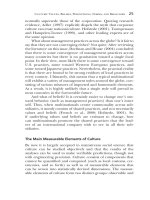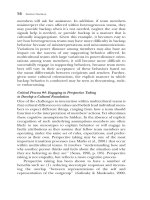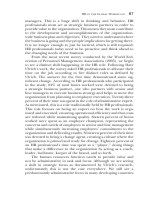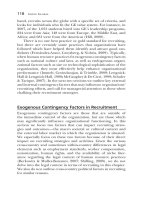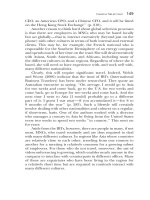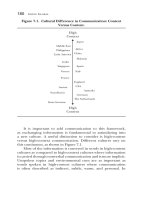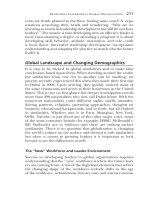Going Global Practical Applications and Recommendations for HR and OD Professionals in the Global Workplace_2 doc
Bạn đang xem bản rút gọn của tài liệu. Xem và tải ngay bản đầy đủ của tài liệu tại đây (554.83 KB, 31 trang )
Culture: Values, Beliefs, Perceptions, Norms, and Behaviors 25
normally supersede those of the corporation. Quoting research
evidence, Adler (1997) explicitly dispels the myth that corporate
culture can erase national culture. Hofstede (2001), Trompenaars
and Hampden-Turner (1999), and other leading experts are of
the same opinion.
What about management practices across the globe? Is it fair to
say that they are not converging either? Not quite. After reviewing
the literature on this issue, Dorfman and House (2004) concluded
that there is some convergence of management practices across
many countries but there is no gravitation toward a single focal
point. In their view, most likely there is some convergence toward
U.S. practices, some toward Western European practices, and
some toward Japanese practices. Nevertheless, the practical reality
is that there are bound to be strong residues of local practices in
every country. Ultimately, this means that a typical multinational
will exhibit a variety of management styles around the globe, con-
sisting of various mixtures of imported and homemade elements.
As a result, it is highly unlikely that a single style will prevail in
most countries in the foreseeable future.
And what of beliefs? It is certainly easier to change one’s out-
ward behavior (such as management practices) than one’s inner
self. Thus, when multinationals create commonality across sub-
sidiaries, it mostly consists of shared practices, and not necessarily
values and beliefs (French et al., 2008; Hofstede, 2001). So
if underlying values and beliefs are resistant to change, how
can multinationals promote the shared practices that the lead-
ers of an international company wish to see in all their sub-
sidiaries.
The Main Measurable Elements of Culture
By now it is largely accepted in mainstream social science that
culture can be studied objectively and that the results of the
analyses can be used to make verifiable predictions, though not
with engineering precision. Culture consists of components that
cannot be quantified and compared (such as local customs, cer-
emonies, and so forth) as well as of measurable elements that
can be woven into statistically derived dimensions. The measur-
able elements of culture form two distinct groups: observable and
26 Going Global
invisible. The first group consists of behaviors and practices that
can either be seen directly or deduced from national statistics,
such as suicide rates, murder rates, birth rates, road death tolls,
alcohol and tobacco consumption, and the like. The second group
comprises what is commonly known as values, beliefs, perceptions,
and norms. Because these are studied by means of questionnaires,
the easiest way to understand what they are is to look at how the
corresponding questionnaire items are worded.
• Values are measured by asking the respondents what is
important to them in their personal lives. Studies of values
have revealed for example that religion, work, and family are
far more important to people in some countries than in others
(Inglehart & Baker, 2000; Minkov, 2007).
• Beliefs are measured by presenting the respondents with
statements and asking them if they agree or disagree. For
instance respondents in some countries are far more likely
than other respondents to believe that men make better
leaders than women (World Values Survey, 2006) or that caring
for societal affairs only brings trouble (Bond et al., 2004).
• Perceptions are measured by asking the respondents how they
perceive some abstract aspects of their own lives, such as their
happiness, health, and life satisfaction, or the degree of control
that they think they have over their own lives. Studies of per-
ceptions (World Values Survey, 2006) have revealed enormous
cross-cultural differences.
• Norms are measured by asking the respondents what values
others should have and what they should do or should not do.
Thus, norms can be called values (or desirable behaviors) for
others. It is crucially important to understand the difference
between people’s personal values and the norms that they
prescribe to others. because these may coincide or be diametri-
cally opposed. For example, a person who is striving for power
may advocate submissiveness as a norm for others (Smith,
2006). The two largest cross-national studies of nationally
representative samples, the World Values Survey (2006) and the
Pew Research Center (2002; 2007), have revealed significant
cross-cultural differences in norms, such as the degree to which
respondents agree that poor people should be helped by the
government or their fellow citizens.
Culture: Values, Beliefs, Perceptions, Norms, and Behaviors 27
Are Some Cultural Ingredients Better Than Others?
The bewildering diversity of values, norms, and practices that one
can observe in different societies often brings up the question
of whether some are better than others. The answer, however,
is highly context-specific. For instance, the values that promote
national economic growth in a particular historical period may
not be the same as at different times or even at the same time in a
different society. Thus, unless the context is clearly specified, it is
difficult to evaluate values and norms in an absolute sense.
Some authors, however, downplay the importance of context
or cultural relativism, as it has become known. Dowling and Welch
(2004), for example, promote the idea of universal values, such as
the biblical ‘‘Thou shalt not kill.’’ They ask whether corruption
is really acceptable in a country like Indonesia, even though
it is a relatively common. Their answer is no, on the grounds
that it is ‘‘morally wrong.’’ However, some would argue that this
answer is culturally specific. In some cases, corruption is viewed
quite differently. For example, I know of East Europeans, North
Africans, and Middle Easterners who have expressed indignation
after Western officials declined their bribe offers. From their own
cultural viewpoint, the Western officials had spurned an offer of
collaboration and friendship. In short, the same practice is viewed
very differently as a function of one’s own cultural context.
This is not a call for Western expatriates to engage in corrupt
practices while working outside their home countries. Quite on the
contrary, as already stated, values are very difficult to change and
Westerners cannot be expected to trade theirs for a different cur-
rency just because it appears to be ‘‘semi-legal tender’’ in a foreign
country. I simply use this example to expose the fallacy of the idea
of a universal morality, and to drive home the notion that when
some Western values are served up to people who have not grown
up with them, they may be as reluctant to adopt them as some West-
erners may be unwilling, or just afraid, to engage in corruption.
Main Cultural Dimensions with Implications
for Cross-Cultural Management
The research literature provides many accounts of cultural dimen-
sions that seem to explain various societal differences, some
of which have implications for management and organizational
28 Going Global
behavior. The following is a brief presentation of those that may be
most useful to an international manager, while being scientifically
sound and reliable.
Individualism versus Collectivism (Universalism
versus Exclusionism)
This is an extremely robust dimension in the sense that it has
appeared in a number of large-scale studies, involving more than
45 nations each, the first of which was that by Geert Hofstede
around 1970 (Hofstede, 2001), followed by Smith, Dugan, and
Trompenaars (1996), Gelfand, Ghawuk, Nishii, and Bechtold
(2004), and Minkov (2007).
There are some divergent opinions concerning the right inter-
pretation of this dimension and what exactly is at its core. Many
view individualism as being synonymous with selfishness and a
preferencetogoitalone.Ithas alsobeeninterpretedas competition-
orientation. Collectivism, on the other hand, is often described as
a willingness to follow others, to cooperate, and to work in teams.
However, these concepts are not meaningfully correlated with the
previously mentioned large-scale measures of individualism versus
collectivism, as the latter reveal a different picture.
Individualism versus collectivism also reflects some of the
important differences between Western and non-Western cultures.
Economically poor societies are often thought of as collec-
tivist because they are characterized by strong and cohesive
in-groups, consisting mainly of clansmen, close friends, and rela-
tives, although the circle may be extended to include other groups,
such as one’s loyal customers and employees. People in collectivis-
tic societies usually feel a strong moral obligation toward in-group
members, which may sometimes assume the form of self-sacrifice.
Out-group members, by contrast, tend to be treated with com-
parative indifference, which can escalate into outright neglect,
negligence, disrespect, derision, and discrimination. In worst-case
scenarios, the result can be open hostility and abuse. As Triandis
(2000) puts it, ‘‘people in collectivist cultures are extremely sup-
portive of their in-group members, but they have a cold, and even
hostile, relationship with out-group members’’ (p. 29).
To avoid misconceptions, and to emphasize the practical impli-
cations of these cultural differences, Minkov (2007) proposed a
Culture: Values, Beliefs, Perceptions, Norms, and Behaviors 29
new name for the individualism-versus-collectivism dimension:
universalism versus exclusionism. Exclusionism (collectivism) can
be viewed as a tendency to treat people on the basis of their group
membership, refusing privileges to out-group members by means
of nepotism and discrimination. Universalism (individualism) is
about the opposite: the degree to which a society is serious about
stamping out nepotism and discriminatory attitudes and practices.
This dimension is also a very strong predictor of corruption, as
measured by Transparency International. Poorer and more exclu-
sionist countries invariably have more corruption. Businesspeople
from a state official’s in-group deserve a preferential treatment
that others are excluded from. If they wish to receive a service or
obtainacontractthatisnotmeantforthem,theonlyrecourse
that they normally have is a bribe.
Shades of gray. It must also be noted that there are shades
of gray with regard to the distinction between individualism and
collectivism. For example, research has shown that the indifferent
or cold attitude toward out-group in collectivistic societies may
disappear in some collectivist countries when strangers are per-
ceived as being in need of help (Levine, Norenzayan, & Philbrick,
2001). Moreover, it would be incorrect to say that the distinction
between in-groups and out-groups is totally unknown in the indi-
vidualistic West, but it is far less pronounced. For example, while
it is clear from the World Values Survey that racism (expressed as
an unwillingness to have neighbors of a different race) is much
stronger in Asia, Africa, the Middle East, and Eastern Europe, the
same survey shows that ‘‘tolerance and respect for others,’’ as a
value that children should learn, is strongest in the West.
Implications for Organizations
Individualism and collectivism have many implications for orga-
nizations, and we now turn to a few of the more obvious or
potentially challenging ones.
Nepotism. Whereas Westerners tend to view nepotism as
morally wrong, it is viewed as more acceptable in poorer exclu-
sionist (individualistic) societies. In those societies, a person can
be dead (literally) without the support of his or her in-group
and is therefore obliged to prioritize commitments in their favor.
30 Going Global
In a poor society with limited resources, this is only natural. By
contrast, refusing preferentialtreatmenttoamemberofone’s
in-group can result in severe sanctions.
As a result, organizations in poor collectivist-exclusionist soci-
eties may look more like families in that personal and professional
relationships are intermixed (Hampden-Turner & Trompenaars,
1996; Trompenaars & Hampden-Turner, 1999). A boss may ask his
subordinates to help him paint his house or run personal errands
for him. He is a father figure who disburses privileges on the basis
of the loyalty and obedience that he receives, not necessarily on
the basis of personally achieved professional goals.
Thus, in exclusionist societies, nepotistic practices can be
quite strong, as are attempts to cover the misdemeanors of in-
group members. ‘‘Nothing personal’’ is a meaningless statement
in this type of culture because nearly everything is personal.
Any direct criticism of an employee’s professional performance
may be interpreted as an assault on his character. Hiring, firing,
and promotions in a company’s hierarchy also reflect the quality
of personal relationships. The idea of sacking an employee for
failing to achieve targets may sound alien. My own consulting
practice shows that when the Western logic of this phenomenon
is explained to people with a strongly exclusionist (collectivist)
mind-set, they find it abhorrent and unworkable. Of course, layoffs
do occur in the poor world during crises, but firing people on the
basis of their mediocre performance, with no concern for their
personal relationship with their manager and peers, can be viewed
as shockingly immoral and incomprehensible.
By contrast, in Western societies, an employee that does not
visibly contribute to the success of the organization is viewed as a
burden that should be jettisoned as soon as possible. A good illus-
tration of the diametrical opposition in management philosophies
that these cultural differences can produce is provided by the nar-
ratives of two of the world’s most famous managers: Jack Welch,
former chief executive of General Electric, and Akio Morita, the
late founder and president of Sony. Welch was proud of a human
resource management system that required the heads of the com-
pany’s different businesses to rank all their managers each year
and lay off the lowest 10 percent (Welch & Byrne, 2001, quoted in
‘‘Jack and the People Factory,’’ 2001, p. 38.). Morita, by contrast,
Culture: Values, Beliefs, Perceptions, Norms, and Behaviors 31
practiced Japanese management, based precisely on the opposite
philosophy. Once he complained to some American colleagues
about an exasperating employee and admitted he did not know
what to do with him. The Americans advised him to fire the
person. ‘‘I was stunned by the idea,’’ Morita wrote, ‘‘I had never
fired anybody and even in this case it had never crossed my
mind. But to solve the problem by firing a man was the Ameri-
can system’’ (Morita, Reingold, & Shimomura, 1986, quoted in
Hampden-Turner & Trompenaars, 1996, p. 175).
Contracting. Universalist (Individualist) societies have a ten-
dency to produce rigid formal contracts that must be respected,
whereas exclusionist ones have a much looser attitude toward
agreements, especially when they involve out-group members
(Minkov, 2007; Trompenaars & Hampden-Turner, 1999). For a
contract to be honored in an exclusionist culture, one may need to
form a very close relationship with one’s business partner, which
effectively guarantees the status of an in-group member (Trompe-
naars & Hampden-Turner, 1999). The universalist cultures of the
rich world and their higher concern for others, regardless of their
group affiliation, have produced formal legislation that makes it
very risky to renege on agreements.
Punctuality. The anecdotal evidence in Trompenaars and
Hampden-Turner (1999), as well as research by Levine and Noren-
zayan (1999), shows that Western cultures differ from the rest
of the world in terms of their greater respect for punctuality
and faster speed of life. This difference has been confusingly
interpreted in terms of a ‘‘synchronic’’ or ‘‘polychronic’’ ver-
sus ‘‘sequential’’ dimension (Trompenaars & Hampden-Turner,
1999, p. 123). In fact, it simply reflects differences in empathy:
lower levels in the poor exclusionist world where people are less
likely to show tolerance and respect for others, higher levels in
the rich universalist world. As Trompenaars (2003) admitted, an
acquaintance of his once made the following statement: ‘‘The
problem of being late is actually the problem of those who are
on time.’’ This means that a lack of punctuality need not be
explained as a different perception of time. It reveals a lack of
empathy and respect for those who are waiting. Similarly, the
so-called polychronic behavior of a clerk in an exclusionist society
who is talking to a friend while dealing with a customer simply
32 Going Global
means that the friend is more important to this person than the
business.
Communication. One of the potentially exasperating differ-
ences between exclusionist and universalist cultures has been
defined as high-context versus low-context communication (Hall,
1959). High-context means beating around the bush: the message is
implicit and parts of it have to be inferred and guessed from the
situation in which it was made or from some external information
about the speaker. Low-context communication involves explicit
statements that leave little room for subjective interpretations.
The fact that Western societies prefer long and precise contracts,
which are atypical in the developing world, owes a lot to this
cultural difference. Western culture is low-context: speaking one’s
mind clearly and precisely and being direct is considered a virtue
as long as one remains polite. But in the high-context exclusionist
world, direct communication of bad news is normally viewed as
rude and inconsiderate. By way of example, Trompenaars and
Hampden-Turner (1999) tell a story about a Western doctor who
was killed by a colleague in a developing country for criticized his
work. Such extreme behavior is very rare but cases when criticising
permanently damages a personal and professional relationship are
very frequent.
Products, services, and safety. One of the most important
implications of universalism versus exclusionism differences for
international managers is the different attitude toward product
and service quality, as well as safety, in the West and the poorer
parts of the world. Alvazzi del Frate and van Kesteren (2004)
report a study evidencing far more frequent consumer fraud in
exclusionist countries than in universalist ones, whereas Trompe-
naars and Hampden-Turner (1999) quote an IMD report on
international competitiveness that includes a ranking on product
safety in 24 developed economies. There is higher concern for
safety in the rich universalist countries.
This is an extremely serious issue for management. In prin-
ciple, it is multinational companies that bring to the developing
world the idea of consistent product and service quality for all
customers and implement it after some considerable effort. For
example, although Bulgaria is considered the homeland of yogurt,
it was not until Danone set up shop in that country in the 1990s that
Culture: Values, Beliefs, Perceptions, Norms, and Behaviors 33
Bulgarian customers could finally buy some yogurt of predictable
quality. Even today, the poor and inconsistent quality of many
food products in Bulgarian stores and the fraudulent practices
of quite a few local producers are hotly debated topics in the
country’s media.
Power Distance and Authoritarianism
Power distance, another key component of culture, has been
thought of in different ways. Hofstede (2001), for example, con-
ceptualized this dimension as the emotional distance between
leaders and their subordinates. GLOBE focuses more on the dis-
tribution of power (Carl, Gupta, & Javidan, 2004) and finally,
Euwema, Wendt, and van Emmerik (2007) talk about directive
leadership as the degree to which managers supervise their sub-
ordinates closely and expect precise and immediate execution
of their orders. Despite these differences, the three concepts are
more similar than different. The basic premise is that leader-
follower relationships are more authoritarian in poor countries,
which means that this dimension creates a geographic distri-
bution that tracks closely with individualism and collectivism.
For example, anecdotal evidence suggests that Asia has greatest
authoritarianism, evident in rigid hierarchies and caste systems,
autocratic leadership, and submissive subordinates. The Scandi-
navian countries and the Netherlands, by contrast, are at the
opposite extreme where an employee challenging the decision
of a manager would not necessarily be viewed as shocking or
disrespectful.
For managers crossing these sorts of boundaries, it can be
challenging, to say the least. For example, a manager from north-
western Europe or an Anglo-Saxon country who is not used to
subservient yea-saying subordinates, but expects initiative and
independent action, may find it terribly frustrating to work with
those who prefer to sit back and wait for direction. In a high-
power distance culture, these sorts of qualities are found primarily
in top leaders and entrepreneurs, whereas middle managers
and employees at lower levels are simply supposed to execute
orders. Even senior staff, such as a company’s director of sales
or human resources manager, may be reluctant to make any
34 Going Global
move without the chief executive officer’s blessing. Attempts to
change this type of culture and introduce notions like participa-
tive management, independent decision making, empowerment,
devolution, delayering, and flat company structures often fail
miserably.
And even when one thinks that changes are executed, the
truth could be far different. Examples from Hofstede (2001),
Trompenaars and Hampden-Turner (1999), and my own practice
demonstrate that even when some change is visible at the sur-
face, the underlying situation may remain unchanged. A Slovak
executive from a large German company in Slovakia once told us
that the German leaders had spent a year on a delayering project.
But the final result showed only on the new company chart. In
practice, the old hierarchies remained in people’s minds and
many employees still expected guidance and orders from those
who had been their bosses.
Uncertainty Avoidance
Hofstede’s uncertainty avoidance (2001), in a nutshell, refers to
the way that cultures respond to changes and deal with ambiguity.
High–uncertainty avoidance cultures are generally thought of as
conservative and law-abiding whereas low–uncertainty avoidance
cultures are open to change, innovation, and diversity. There
has, however, been some confusion around rule orientation and
specifically whether or not this is indicative of one’s own personal
values. For example, if personalvalues guide behavior, then people
in Southern and Latin Europe, where Hofstede’s uncertainty
avoidance reaches its highest scores, should be the most law-
abiding, but many observers have been puzzled by what they
have seen in reality—a seeming South European tendency to
break rules. What are we to make of this? The answer lies in
the difference between personal values and norms for others. In
Bulgaria for instance, the typical philosophy seems to be others
should be very rule-oriented but I must be allowed to break the rules
if it serves my own interest. Thus, while Hofstede’s uncertainty
avoidance may explain how people in some countries react to
other people’s transgressions it does not necessarily tell us about
people’s personal rule orientation.
Culture: Values, Beliefs, Perceptions, Norms, and Behaviors 35
And like anything else, there are shades of gray. For example,
regardless of where they fall on the uncertainty avoidance scale,
no society on earth is without some unbendable rules that every-
body respects. People in southern Europe make more traffic
violations than those in northwestern Europe, but they respect
various other stringent rules that others may not have heard of.
For example, Bulgarians never give a woman an even number
of flowers. Another example: Indonesians drive in a way that
can make a Westerner’s hair stand on end, but they have innu-
merable indigenous social regulations from which they never
deviate.
Masculinity versus Femininity
Hofstede’s ‘‘masculinity versus femininity’’ dimension is also often
misinterpreted, at least in two ways. First of all, it has nothing to do
with male dominance over women, as many people think. Second,
it is not a measure of achievement orientation or competitiveness
in an absolute sense. It is about the prioritization of achievement
versus personal relationships in the workplace. It reveals which
of the two would be more important if employees had to choose
only one of them. According to Hosfstede’s data (2001) from IBM
around 1970, employees in so-called masculine cultures (such
as Japan) attached a higher importance to achievement than to
relationships, whereas the situation in so-called feminine countries
(such as Guatemala) was precisely the opposite. Nevertheless,
Japan’s achievement orientation score was far lower than the
score of Guatemala. In an absolute sense, Guatemala was much
more achievement oriented than Japan.
The World Values Survey, which relies on nationally repre-
sentative data, rather than matched samples from one and the
same corporation, shows a somewhat different pattern of work-
goal prioritization. In the majority of poor countries, the most
important goals are earnings and job security, whereas achieve-
ment and relationships are usually lower on people’s priority lists.
In the United States and Australia, the most important goals are
achievement and earnings; relationships are less important. But
in Japan, Germany, and the Scandinavian countries, relationships
come first.
36 Going Global
Societal Cynicism
Bond and associates (2004) proposed a research-based cultural
dimension called ‘‘societal cynicism.’’ It is measured by responses
to statements such as ‘‘To care about societal affairs only brings
trouble to yourself,’’ ‘‘Kind-hearted people usually suffer losses,’’
‘‘Old people are usually stubborn and biased,’’ ‘‘People will stop
working after they secure a comfortable life,’’ and so on. It
also reflects a view that powerful people are arrogant exploiters.
According to the available data, societal cynicism is strongest
in Eastern Europe, East Asia (Korea, Taiwan), Pakistan, and
Thailand. It is weakest in Norway, the United States, and Canada.
If this relatively new dimension is replicated and confirmed
in further studies, it may have serious implications for interna-
tional management. For example, American managers in Eastern
Europe often wonder why they have to go to unusual lengths to
gain the trust of their subordinates. Societal cynicism may provide
a plausible explanation: in cynical cultures, employees and man-
agers may form oppositional identities that are hard to dismantle.
It is also likely that differences in societal cynicism partly account
for different attitudes toward corruption.
Utilitarian Versus Loyal Involvement
Smith, Dugan, and Trompenaars (1996) studied the norms and
beliefs of 8,841 managers and employees from 43 countries
and identified a dimension they called ‘‘utilitarian versus loyal
involvement.’’ What it measures is the propensity and willingness
to work in a team and share responsibility with others. Their
research revealed that individuals in Asia show the highest level
and Eastern Europeans score lowest. This dimension captures a
phenomenon that any Bulgarian, and probably some other East
Europeans, will be aware of. My colleague Michael Minkov and I
have asked various groups of Bulgarians—business students, com-
pany employees, and even high school students—whether they
like to work in teams, and have often heard a resounding ‘‘no,’’
oftenaccompaniedbyawrygrimace.Attemptsbymanagersfrom
English-speaking countries to change this attitude are not likely
to result in quick success in any society where people prefer to be
given individual tasks and then be left alone.
Culture: Values, Beliefs, Perceptions, Norms, and Behaviors 37
Economic Dynamism
Minkov and Blagoev (2009) have proposed a new cultural dimen-
sion extracted from World Values Survey data. Starting from the
views of leading development economists concerning the deter-
minants of economic growth, and in particular of the East Asian
economic miracle, we show a parallel between the factors pro-
posed by the economists and a number of cultural values. We
demonstrate that nations that attached a higher importance to
thrift and a lower importance to leisure in the 1998–99 wave of
the World Values Survey registered considerably faster economic
growth in the next decade. We also found that these nations attach
a lower importance to personal relationships. The highest scorers
on this dimension, which we called ‘‘economic dynamism,’’ are
East Asian and East European nations. The lowest scorers are the
Latin American countries.
This dimension provides serious food for thought not only
to national governments but also to international managers.
When expatriates from a country that scores high on economic
dynamism become managers in one with a low score, they may
perceive the local workforce as indolent and unacceptably fun-
oriented. Paik and Derick Sohn (1998) quote South Korean
managers in Mexico who were upset by the fact that their work-
ers listened to radios and talked a lot, instead of concentrating
on their work without getting distracted, which seems to be the
normal state of affairs in South Korea.
Project GLOBE’s Leadership Dimensions
During the 1990s, Project GLOBE studied the preferred lead-
ership style in 62 societies (House et al., 2004). The results
specific to leadership from this study are presented in Dorfman,
Hanges, and Brodbeck (2004). Six preferred leadership dimen-
sions were extracted, describing broad leadership styles. Although
these dimensions are still new to academics and practitioners
alike, they are interesting. For example, they reveal that charis-
matic leadership, which captures the attention of many American
researchers, is indeed highly valued in the Americas, but far less so
in many other countries, where employees rank the importance
of effective leadership traits in a different way.
38 Going Global
Although the GLOBE study is well known and widely cited,
it is not without controversy. One issue of contention has to
do with the fact that the authors asked respondents to describe
their societies as well as the personalities of their fellow citizens.
McCrae, Terracciano, Realo, and Allik, (2007; 2008), however,
argued that this approach yields meaningful results only when the
issues that the respondents are asked to discuss are very simple
and very salient. A simple and salient issue could be the size of the
typical family in a given society. Any question at a higher level of
abstraction can result in answers that do not contain meaningful
information for cross-cultural comparisons. Question v163 in the
World Values Survey Association (2008), for example, asks the
respondents how much ‘‘democraticness’’ there is in their own
countries. According to the nationally representative samples,
there is more democraticness in Ghana, Vietnam, and Jordan
than in any Western country, such as Switzerland, Germany, the
United States, Sweden, and Finland.
There is a very important practical lesson here that inter-
national managers and consultants should remember. Asking a
country’s citizens to provide information about their own culture
can be double-edged. It can result in valuable information or
meaningless statements, depending on what you ask about.
Cultural Diversity: A Nuisance
or a Competitive Advantage?
In this chapter, we have presented just a fraction of the bewilder-
ingly rich cross-cultural variation in the world. The full extent and
depth of cultural differences are hard to fathom and probably
impossible to ever catalogue completely. And as we ponder those
differences, it is worth revisiting the notion of cultural diversity
and whether it is an aid or a hindrance to organizations. The
answer is complicated and depends on how you look at this topic.
Managers Managing Cultural Diversity
As international managers attempt to navigate these challenging
waters, there are probably two obvious ways that they can quickly
run into problems with respect to culture. Understanding these
Culture: Values, Beliefs, Perceptions, Norms, and Behaviors 39
problems can help turn culture from a nuisance to an advantage.
The first is when managers are simply unaware of the many
nuances around cultural differences. The good news is that, to
some extent, lack of awareness can be remedied through cross-
cultural training, coaching, time on the ground, and so forth. And
while this may not guarantee cultural ‘‘fluency,’’ it can go a long
way toward giving the manager a good working knowledge of the
relevant norms, values, and expected behavior.
The second way that managers can get into trouble is per-
haps more problematic, and that has to do with individuals who
may or may not be aware of the cultural nuances but regard-
less seek to impose their own norms and values and discount
those of others. A statement by two consultants with substan-
tial cross-cultural knowledge and experience perhaps exemplifies
the challenge of trying to change others: ‘‘Perfect integration
between Western expatriates and local executives appears to be
impossible’’ (Browaeys & Price, 2008, p. 294). And this is not
a subjective opinion without basis in evidence. It summarizes
the findings of a study of Afro-Occidental teams by African and
Western scholars. And it is a sobering call for realism. Instead of
expecting easy and complete solutions to all cross-cultural prob-
lems, managers may sometimes have to accept that some serious
and possibly unpalatable differences will remain. There may be
no further solution but to accept the situation by simply grinning
and bearing it.
International managers also need to keep in mind that there
is often a logic behind the differences that they may come across.
Specifically, different geographic, historical, and social environ-
ments will have created different cultures, all of which are quite
logical in their particular settings, even if a foreign national fails
to see this right away. Understanding this can be a major first
step toward a reduction of the discomfort that people often expe-
rience in an unfamiliar society, where things can seem to be
upside down. Then, managers can work out ways to deal with the
challenges of the local culture by accommodating its own logic.
A study of Korean management in Mexico provides a good illustra-
tion of culture-sensitive conflict resolution. The Korean managers
realized the great importance of the family in Mexican society and
40 Going Global
helped their workers deal with various family-related problems. As
a result, the Mexican workers responded with greater commitment
and work motivation. Trompenaars and Hampden-Turner (1999)
provide an account of how forming a strong personal relationship
in a collectivist culture can improve professional relationships
between business partners.
It is also important to remember the adage that each half-
empty glass is also half-full. Although cultural differences may be
assumed by some to be an impediment to the development of a
company, the opposite may actually be true. Instead of an impedi-
ment, those unique cultural aspects could actually be an advantage
that does not exist at home. For example, Western managers may
chafe at the tendency in some cultures for subordinates to be
passive, unwilling to assume personal responsibility, and lack-
ing initiative, but the other side of the coin is that managers’
decisions could actually be implemented more swiftly. At the
end of the day, it would seem that what’s really key is that
international managers (and their organizations) understand the
cultural nuances as much as is reasonably possible, and adjust
their practices to make the best of the situation for their employ-
ees, the organizations, and other relevant stakeholders. After all,
there is enough research to prove that different branches of
one and the same multinational may use different management
styles—authoritarian versus participative—and obtain the same
financial results. The ability to see different paths to one and
the same goal and assess the utility of one and the same cultural
trait from different angles should be a major goal of cross-cultural
training.
It’s All Relative
Let us also once again address the issue of cultural relativism.
This relativism itself is also relative and not at all absolute. But
the reasons for this are practical and have nothing to do with a
universal morality. For example, it is true that company growth
and profit can be achieved in different ways and by making use
of different cultural values, beliefs, norms, and behaviors. But it
is not true that just any cultural values, beliefs, and behaviors
can be conducive to growth and profit. For instance, a strong
Culture: Values, Beliefs, Perceptions, Norms, and Behaviors 41
distinction between in-groups and out-groups in an exclusionist
society is often maintained in business relationships as well: in-
group members are entitled to goods of better quality and better
service. However, this practice generally hinders company growth
because it creates a dividing line between a limited number of in-
group members and the unlimited numberofout-group members.
Evidently, this particular aspect of a strongly exclusionist mind-set
needs to be treated as a cause of concern by any manager who
believes in company growth.
Another example has to do with the entrenched belief in the
West that men and women are equal and must be treated accord-
ingly. Even if a company in a developing country can discriminate
against women and still achieve strong profit, this practice will
never be accepted by the representatives of mainstream Western
culture. Trompenaars (2003) explains how a Western female man-
ager was rejected in a country where men do not believe in gender
equality, only to be fully accepted after the local people were
informed that she was an extraordinary person at home, com-
manding very high social prestige. However, this may not work
equally well for local women. How to resolve gender inequality
problems in societies where women have been kept away from
leadership for millennia is not a question that has an easy answer
for multinationals operating in those societies.
Not Comfortable, Just Wait a While
For those who find some cultural practices to be in the marginal
zone of what they consider ethically acceptable (that is, a nui-
sance), they may find solace in the knowledge that economic
development generally brings about profound cultural change,
generally toward Western universalist values. Before it became
wealthy, the Western world had a strongly exclusionist culture.
And though it took centuries of economic development for it
to become as universalist as it is today, it also seems to be the
case that many of the developing countries around the globe are
changing at a faster pace than ever before. In China, for example,
thinking around thrift that developed over centuries seems to be
changing overnight. And though the deep underlying values may
not turn on their head quite so quickly, there is no question that
42 Going Global
technology and the easy access to information that comes with it
are having a dramatic impact on these developing societies. Thus,
elements of culture which may be a nuisance now in terms of
creating competitive advantage, in time, may abate over time.
Organizations as a Nuisance Variable
Finally, some seemingly cultural problems are simply generated by
poor management. At the 2008 annual conference of CEEMAN
(Central and East European Management Development Associa-
tion) in Tirana, the owner of various large businesses in the Repub-
lic of Macedonia—who is a national of that country—complained
that the typical employee in the Balkans is not sufficiently moti-
vated to work hard because he does not have the Protestant
values of the Anglo-Saxon world. Complaints that other East Euro-
peans also have a poor work ethic and are almost unmanageable
are often heard from prominent local entrepreneurs. A better
understanding of these apparent nuisance factors, however, can
be gained by looking at recent history. After the breakup of
the socialist-communist system, some businesses ended up in the
hands of self-made people who thought that effective manage-
ment could be practiced without any understanding of human
psychology and motivation. As a result, some of their practices
were downright awful, consisting mainly of military methods. The
natural result was disgruntled employees with cynical attitudes
toward their companies, something that had nothing to do with
the local culture. So the final lesson for international managers
is that what may at first blush seem like ‘‘culture’’ could, upon
further examination, be revealed as the result of something quite
different.
References
Adler, N. J. (1997). International dimensions of organizational behavior.
Cincinnati, OH: South-Western.
Alvazzi del Frate, A., & van Kesteren, J. (2004). Criminal victimization
in urban Europe; Key findings of the 2000 international crime victim
surveys. United Nations Interregional Crime and Justice Research
Institute. Internet publication. Retrieved Jan. 8, 2007, from
www.unicri.it/wwd/analysis/icvs/pdf
files/
CriminalVictimisationUrbanEurope.pdf.
Culture: Values, Beliefs, Perceptions, Norms, and Behaviors 43
Bond, M. H., et al. (2004). Culture-level dimensions of social axioms
and their correlates across 41 cultures. Journal of Cross-Cultural
Psychology, 35, 548–570.
Brown, D. (1991). Human universals. New York: McGraw Hill.
Browaeys, M. J., & Price, R. (2008). Understanding cross-cultural manage-
ment. Harlow, UK: Prentice Hall.
Carl, D., Gupta. V., & Javidan, M. (2004). Power distance. In R. J. House,
P. J., Hanges, J. Mansour, P. W. Dorfman, & V. Gupta, V. (Eds.).
Culture, leadership, and organizations. The GLOBE study of 62 societies.
Thousand Oaks, CA: Sage.
Dorfman, P. W., Hanges, P. J., & Brodbeck, F. C. (2004). Leadership and
cultural variation. In R. J. House, P. J., Hanges, J. Mansour, P. W.
Dorfman, & V. Gupta, V. (Eds.). Culture, leadership, and organizations.
The GLOBE study of 62 societies. Thousand Oaks, CA: Sage.
Dorfman, P. W., & House, R. J. (2004). Cultural influences on organiza-
tionalleadership.InR.J.House,P.J.,Hanges,J.Mansour,P.W.
Dorfman, & V. Gupta, V. (Eds.). Culture, leadership, and organizations.
The GLOBE study of 62 societies. Thousand Oaks, CA: Sage.
Dowling, P. J., & Welch, D. E. (2004). International human resource man-
agement. London: Thompson Learning.
Euwema, M. C., Wendt, H., & van Emmerik, H. (2007). Leadership
styles and group organizational citizenshipbehavior across cultures.
Journal of Organizational behavior, 28(8), 1035–1057.
French, R., et al. (2008). Organizational behaviour. Chichester, UK: Wiley.
Gelfand,M.J.,Ghawuk,D.P.S.,Nishii,L.H.,&Bechtold,D.J.
(2004). Individualism and collectivism. In R. J. House, P. J., Hanges,
J. Mansour, P. W. Dorfman, & V. Gupta, V. (Eds.). Culture, leadership,
and organizations. The GLOBE study of 62 societies. Thousand Oaks,
CA: Sage.
Hall, E. T. (1959). The silent language.NewYork:AnchorBooks.
Hampden-Turner, C., & Trompenaars, F. (1996). The seven cultures
of capitalism; Value systems for creating wealth in the United States,
Japan, Germany, France, Britain, Sweden, and the Netherlands.London:
Piatkus.
Hofstede, G. (2001). Culture’s consequences. Comparing values, behaviors,
institutions, and organizations across nations. Thousand Oaks, CA:
Sage.
House, R. J., Hanges, P. J., Mansour, J., Dorfman, P. W., & Gupta, V.
(Eds.) (2004). Culture, leadership, and organizations. The GLOBE study
of 62 societies. Thousand Oaks, CA: Sage.
Inglehart, R., & Baker, W. E. (2000). Modernization, cultural change, and
the persistence of traditional values. American Sociological Review, 65,
1, 19–51.
44 Going Global
Jack and the people factory. (Sept. 17, 2001). Fortune,38.
Levine, R. V., & Norenzayan, A. (1999). The pace of life in 31 countries.
Journal of Cross-Cultural Psychology, 30(2), 178–205.
Levine, V. R., Norenzayan, A., & Philbrick, K. (2001). Cross-cultural
differences in helping strangers. Journal of Cross-Cultural Psychology,
32, 543–560.
McCrae, R. R., Terracciano, A., Realo, A., & Allik, A. (2007). Climatic
warmth and national wealth: Some culture-level determinants of
national character stereotypes. European Journal of Personality, 21,
953–976.
McCrae, R. R., Terracciano, A., Realo, A., & Allik, J. (2008). Interpreting
GLOBE Societal Practices Scales. Journal of Cross-Cultural Psychology,
39, 805–810.
Minkov, M., & Blagoev, V. (2009). Cultural values predict subsequent
economic growth. International Journal of Cross-Cultural Management,
9(1), 5–24.
Minkov, M. (2007). What makes us different and similar: A new interpretation
of the World Values Survey and other cross-cultural data. Sofia, Bulgaria:
Klasika i Stil.
Morita, A., Reingold, E. M., & Shimomura, E. (1986). Made in Japan: Akio
Morita and the Sony Corporation. New York: Dutton.
Paik, Y. S., & Derick Sohn, J. H. (1998). Confucius in Mexico: Korean
MNCs and the maquiladoras. Business Horizons, 41(6), 25–33.
Pew Research Center. (2007). Global opinion trends 2002–2007. Internet
publication. Retrieved Feb. 20, 2008, from />reports/pdf/257.pdf and />257topline-trend.pdf.
Pew Research Center. (2002). What the world thinks in 2002. How global
publics view their lives, their countries, the world, America. Internet
publication. Retrieved Nov. 8, 2005, from />reports. (Survey results in />165topline.pdf).
Schneider, S. C. (1988). National vs. corporate culture: Implications for
human resource management. Human Resource Management, 2(2),
231–246.
Smith, P. B. (2006). When elephants fight, the grass gets trampled:
The GLOBE and Hofstede projects. Journal of International Business
Studies, 37, 915–921.
Smith, P. B., Dugan, S., & Trompenaars, F. (1996). National cul-
ture and the values of organizational employees: A dimensional
analysis across 43 nations. Journal of Cross-Cultural Psychology, 27,
231–264.
Culture: Values, Beliefs, Perceptions, Norms, and Behaviors 45
Triandis, H. C. (2000). Cultural syndromes and subjective well-being.
In E. Diener, & M. E. Suh. (Eds.). Culture and subjective well-being.
Cambridge, MA: MIT Press.
Trompenaars, F. (2003). Presentation at the Presidents’ Forum, October
2003, International Executive Development Center, Bled, Slovenia.
Trompenaars, F., & Hampden-Turner, C. (1999). Riding the waves of
culture. London: Nicholas Brealy.
Welch, J. F., & Byrne, J. A. (2001). Jack: Straight from the gut.NewYork:
Warner Books.
World Values Survey (2006). On-line data analysis. Retrieved in
June–November, 2006, from www.worldvaluessurvey.com.
World Values Survey Association (2008). World Values Survey 2005
official data file, v.20081015. Madrid: ASEP/JDS. Retrieved Nov. 12,
2008, from www.worldvaluessurvey.com.
CHAPTER 3
Multicultural Teams:
Critical Team Processes
and Guidelines
C. Shawn Burke, Marissa L. Shuffler,
Eduardo Salas, and Michele Gelfand
In the twenty-first century, global organizations are no longer the
exception, but the norm. Global organizations and the resulting
multicultural workforce can have tremendous benefits as talent
and resources are no longer limited by geography. Having a
global workforce has been argued to be a way to drive innovation
and competitiveness by facilitating access to a wider pool of
approaches, resources, and networks. Therefore, it is often the
case that even organizations that are solely located within a single
country have a culturally diverse workforce when members are
recruited based on talent and not location.
In addition to organizations becoming increasingly global,
another trend that has emerged is the move toward team-based
organizations where a predominant amount of the work is facil-
itated through the use of work teams. Such teams have been
characterized as being composed of two or more individuals who
interact adaptively and interdependently toward a common goal
(Salas, Dickinson, Converse, & Tannenbaum, 1992). Recently
there has been increasing interest in what happens when these
two trends intersect, thus resulting in the use of multicultural
work teams. Multicultural teams are defined as a team (see Salas
et al., 1992) whose members have diverse values and beliefs
46
Multicultural Teams: Critical Team Processes and Guidelines 47
based on their cultural orientation. The interaction within these
teams primarily reflect intercultural interaction versus intracul-
tural interaction.
In seeking to provide guidance to organizations, there has
been a fair amount of work conducted that examines intracul-
tural differences in group- or team-based work. For example,
research has shown that cultural differences have implications for
cooperation (for example, Kirkman & Shapiro, 2001; Cox et al.,
1991), communication (Conyne et al., 1999), feedback (Earley
et al., 1999), conflict type (Elron, 1997; Mortensen & Hinds,
2001), cohesion (Man & Lam, 2003; Elron, 1997), team efficacy
(Gibson, 1999), adaptation (Harrison, McKinnon, Wu, & Chow,
2000), decision making (Kirchmeyer & Cohen, 1992), and team
performance (Elron, 1997; Gibson, 1999; Kirkman & Shapiro,
2001; Man & Lam, 2003; Matveev & Nelson, 2004; Gelfand, Erez,
& Aycan, 2007). However, as organizations increasingly rely on
multicultural work teams, often overlooked are the challenges
inherent in leading and working within teams in which individu-
als have vastly different backgrounds, traditions, motivations, and
concerns (Dinwoodie, 2005).
If there are cultural differences in teamwork when looking
intraculturally across cultures, the challenges they pose are com-
pounded when multiple cultures are placed within a single team;
however, it has been argued that these teams can be effective to the
degree to which they are able to manage the need for consensus
versus the need for diversity (Argote & McGrath, 1993). Although
diversity in skills and perspectives may benefit multicultural teams,
the team also needs a degree of common ground in order to facil-
itate coordinated action and the understanding that leads to that
coordination (Argote & McGrath, 1993). Within organizational
teams diversity is often a feature that cannot be escaped, but is
a function of the operating environment. The question becomes
‘‘What does within team diversity in multicultural teams mean for
team interaction and correspondingly teamwork?’’
The purpose of the current chapter is to first highlight some
of the challenges inherent in working within multicultural teams.
In doing so, key processes and emergent states will be briefly
described, resulting in a framework within which to think about
multicultural teams. Next we identify several guidelines that may
48 Going Global
be used by practitioners. These guidelines are grouped based
on their temporal nature (that is, whether they occur before
interaction, during interaction, or post interaction).
What Are the Implications of Intracultural
Differences for Teamwork?
National culture has been defined in many ways: as (1) ‘‘ a
coalescence of discrete behavioral norms and cognitions shared
by individuals within some definable population that are distinct
from those shared with other populations’’ (Lehman, Chiu, &
Schaller, 2004, p. 690), and (2) ‘‘shared motives, values, beliefs,
identities, and interpretations of meanings of significant events
that result from common experiences of members of collectives
and are transmitted across age generations’’ (House & Javidan,
2004, p. 15). Although there is no universally accepted definition
of culture, after reviewing the multitude of definitions within the
social sciences, Triandis (1996) argues that there is wide agree-
ment across definitions that culture consists of ‘‘shared elements
that provide standards for perceiving, believing, evaluating, com-
municating, and acting among those who share a language, a
historic period, and a geographic location’’ (Shweder & LeVine,
1984, p. 408).
The challenge within multicultural teams lies within the fact
that individuals who often have extremely disparate conceptual-
izations of how teams should function are required to engage in
interdependent interaction (Ilgen, LePine, & Hollenbeck, 1997).
Moreover, these culturally based differences are often implicitly
held and are only recognized once the team is heading down a
path to derailment. Gibson and Zellmer-Bruhn (2001) empirically
examined the idea that individuals from different cultures may
have different teamwork prototypes (i.e., metaphors), which in
turn, reflect underlying assumptions about a team’s functionality
and structure. Specifically, interviews were conducted in which
individuals from a variety of cultures were asked general questions
about teamwork. The transcripts from these interviews were then
content coded and sorted based on thematic similarities.
Results indicated the emergence of five differential metaphors
for teams (for example, sports, military, family, associates, and
Multicultural Teams: Critical Team Processes and Guidelines 49
community). Within individualistic cultures there was a ten-
dency for teams to be described in terms of sports and associate
metaphors. Sports metaphors reflected a conceptualization of
teams whereby roles are explicitly defined, there is little hierar-
chy, membership tends to be voluntary, scope of activity is fairly
narrow, and objectives tend to be well defined (Gibson & Zellmer-
Bruhn, 2002). Associate metaphors were used to conceptualize
a view of teams in which there was little role definition, a nar-
row scope of activity related to professional work, and objectives
were explicit, yet evolving and not focused solely on task-related
outcomes (Gibson & Zellmer-Bruhn, 2002).
Conversely, metaphors reflecting family and community
tended to be used most often with collectivists. Herein, teams
were conceptualized using a family metaphor in which there was
a paternalistic hierarchy, activity scope was broad, and objectives
were more social in nature (Gibson & Zellmer-Bruhn, 2002). In
contrast, community metaphors indicated a conceptualization
whereby roles were informal and shared, activities and objectives
were broad in scope and somewhat ambiguous. Perhaps used
less often was the military metaphor, being primarily used by
those valuing power distance (Gibson & Zellmer-Bruhn, 2001).
This metaphor reflected a strict hierarchical structure, limited
scope, and task-focused salient outcomes. These differences
in metaphor use point to the potential difficulty in building
shared cognitive structures (for example, shared mental models,
transactive memory systems) within multicultural teams.
Similar in nature is work that has shown that culture has
an impact on what is considered success in work groups. For
example, Sanchez-Burks, Nisbett, and Ybarra (2000) reported
that cultures that were more collectivistic (for example, Mexico)
valued socioemotional outcomes over task-based outcomes. The
reverse was true for a sample of Anglos. The work by Sanchez-
Burks et al. (2000) as well as that by Gibson and Zellmer-Bruhn
(2001; 2002) offer important insights into challenges that may
arise for individuals working within multicultural teams, as well as
for the leaders responsible for directing and shaping those teams.
For example, Gibson’s work suggests that within a multicultural
team it is likely that the members may come to the team with
disparate ideas pertaining to role structure, activity scope, and


